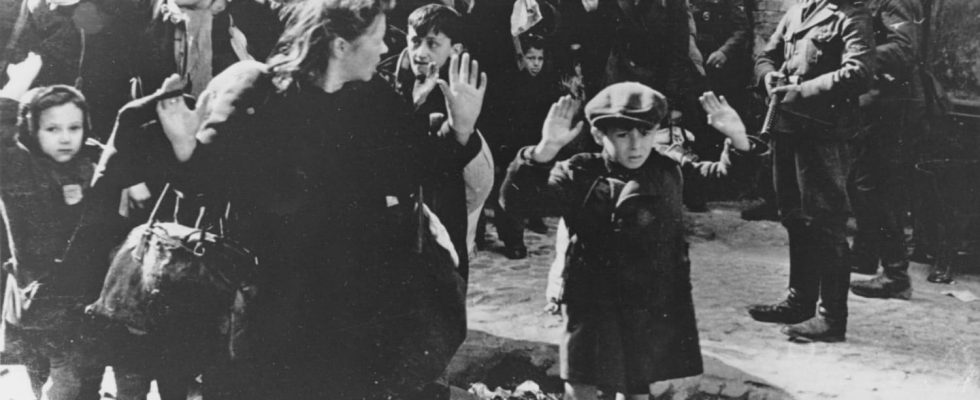WARSAW GHETTO. Eighty years ago, Jews in the Warsaw ghetto rose up against Nazi oppression, hoping to escape deportation. Back to this tragic episode of the Second World War.
THE April 19, 1943 marks the start of the Warsaw Ghetto Uprising, a historic event that is remembered as one of the most courageous acts of the jewish resistance during the Second World War. For nearly a month, the Jews of the ghetto fought fiercely against the Nazi forces, despite their inferiority in terms of armament and means. This revolt was a response to the policy of deportation and extermination carried out by the Germans against the Jewish population of Warsaw. She was also a symbol of resistance in the face of Nazi oppression. Today, 80 years after that uprising, learn about the history of the Warsaw Ghetto, where thousands of people lived in deplorable conditions.
Summary of the Warsaw Ghetto – Erected in 1940 under the Nazi occupation, the Warsaw ghetto brings together the Jewish population of the Polish capital, as well as neighboring towns. Initially, it included nearly 138,000 people and reached up to 439,000 inhabitants. The living conditions are deplorable. In addition to overcrowding, housing is unsanitary and poorly heated. Added to this is malnutrition and problems with the supply of food and fuel. Tuberculosis, typhus… epidemics are quick to break out. In order to avoid aggravated contamination, it is then necessary to pick up the bodies in the streets to group them in mass graves. In mid-1942, the Nazis began deporting Jews to concentration camps. THE April 19, 1943the JCO (Jewish Combat Organization) leads the uprising against German soldiers. Despite the defeat of the insurgents, the movement had a noticeable impact on resistance to Nazi occupation.
Who created the Jewish ghetto in Warsaw in 1940?
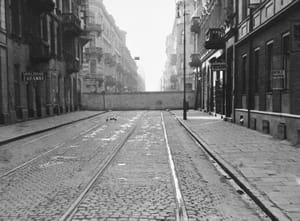
As a reminder, the ghetto defines a neighborhood or a restricted geographical area where Jews are forced to live by political decision of state authorities. One of the main objectives is to separate them from the so-called “non-Jewish” population. The term translates more generally the isolation of a certain part of the population in a specific sector. A year after the invasion of Poland in 1939, the German army multiplied the acts of persecution against the Jews. Identification of Jews by the star of david, confiscation of their property, ban on using public transport… The Warsaw ghetto was set up at the end of 1940, under the Nazi occupation. On November 16, an 18-kilometre-long wall was erected to lock up the Jewish population in neighborhoods imposed by the Nazis. The ghetto is located in the center of the Polish capital. It consists of two parts, respectively the big and the little ghetto.
What were the living conditions like in the Warsaw ghetto?
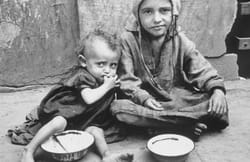
Within the Warsaw ghetto, living conditions became deplorable. This is primarily due to the problem of overcrowding. Nearly 40% of the city’s Jews live in neighborhoods that do not exceed 8% of the total area of the Polish capital, or 128,000 inhabitants per square kilometer. In 1940, it is estimated that seven people lived in one room. Other factors considerably deteriorate the living conditions of the Jews. We can mention the problems of malnutrition, hunger, cold, and unsanitary housing. Food and fuel supplies generated dissension and led some residents to organize trafficking with the population outside the Warsaw ghetto. At the same time, people are forced to work from an early age. Added to this are multiple epidemics, such as tuberculosis and typhus, as well as exhausting work. It is not uncommon for corpses to litter the sidewalks and streets. The survivors themselves are responsible for removing the bodies to move them to mass graves. The excess mortality worsened when, in 1942, German soldiers began the deportation Jews from the Warsaw ghetto.
What happened during the Warsaw Ghetto Uprising in 1943?
In 1942, the deportation operations led to the creation of groups of resistance, such as the Jewish Combat Organization (JCO) and the Jewish Military Union (UMJ). The first clashes occurred in January 1943. However, the uprising in the Warsaw ghetto began on April 19, 1943. The Germans were ordered to destroy the ghetto. At the end of May 16, the revolt is under control. It ended in 13,000 deaths and 58,000 deportations. The German army has 17 dead and less than a hundred wounded. This movement will lead to other acts of resistance, including theWarsaw uprising in 1944. This last event is an armed uprising that took place between August 1 and October 2, 1944. The Polish resistance (or Armia Krajowa) then leads theOperation Storm. This aims to liberate the city from German occupation. This battle opposed nearly 90,000 men. In the space of two months, there were more than 35,000 dead, as many wounded, as well as 15,000 prisoners of war. The confrontation ended in a German victory which also caused the loss of 160,000 to 250,000 civilians.
Who are the survivors and the dead of the Warsaw ghetto?
If we deplore nearly 13,000 dead at the end of the Warsaw Ghetto Uprising of 1943, and about 90,000 dead in total, there are also survivors. One of the best known remains Marek Edelman, commander at the head of about fifty insurgents. We can also mention Simcha Rotem, another fighter and emblematic figure of the Jewish Combat Organization (JCO). Among the survivors, many civilians have shared their testimonies over the decades, including Larissa Cain, Sam Hoffenberg, Liliane Riedler and Leon Najberg. Here are some notable deaths from this episode of the Second World War: Izrael Chaim Wilner, Mordechaj Anielewicz, Dawid Moryc Apfelbaum and Pawel Frenkel.
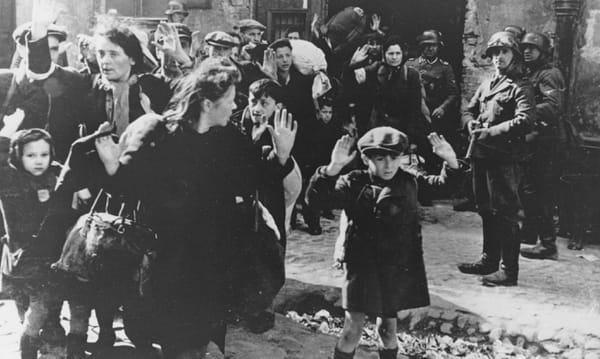
What remains of the Warsaw ghetto today?
The Warsaw ghetto was completely destroyed. Only a few walls and fragments remain between the current buildings. Originally 18 kilometers long, remains can still be seen on Zlota Street, Waliców Street, Krochmalna Street and Stawki Street, to name but a few examples. There are also memorials and commemorative plaques to identify historic locations. The Warsaw Ghetto covered about 300 hectares of the area of the Polish capital, in its center. Here is an interactive map of the ghetto:
Can you visit the Warsaw Ghetto?
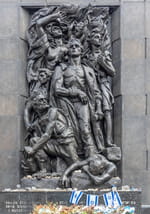
Given its total destruction, it is not possible to visit the Warsaw ghetto. However, you can go to warsaw ghetto memorial which has two monuments. The first was inaugurated in 1946 and pays tribute to the insurgents of the 1943 uprising. A second appeared two years later. It consists, among other things, of bronze sculptures, as well as reliefs arranged on a block of cut stone almost 11 meters high. This second monument faces the Museum of the History of Polish Jews. Its inauguration took place on April 19, 2013, the 70th anniversary of the Warsaw Ghetto Uprising. The place welcomes nearly 450,000 visitors a year.
The key dates of the Warsaw Ghetto
- April 19, 1943 – The Warsaw Ghetto Uprising
- The insurrection of the Jews against the Nazi occupier comes after a firm opposition of the deportations of the population of the ghetto of Warsaw towards the concentration camps. The first resistance movements took place at the beginning of 1943 to intensify 4 months later. Between 400 and 900 fighters face the German soldiers for almost a month. On May 16, there were 13,000 dead in the ghetto. More than 58,000 deportations followed.
- October 2, 1944 – Warsaw Uprising
- Also called the Warsaw Uprising, this episode of the Second World War occurred on August 1, 1944 with Operation Storm. It is led by the Armia Krajowa, the Polish resistance. The objective is to liberate the Polish capital and allow the Red Army to have a strategic point for the advance of its troops. However, on October 2, the uprising was brought under control by the Nazis after more than two months of fighting. All camps combined, there are nearly 35,000 dead.
- January 17, 1945 – Liberation of Poland
- The beginning of 1945 marked the liberation of Poland by the Russian army after five years of German occupation. The capital is in ruins, while a large part of the population has been killed or deported. The losses are estimated at 200,000 dead, mostly civilians, during the period 1940/1945.
